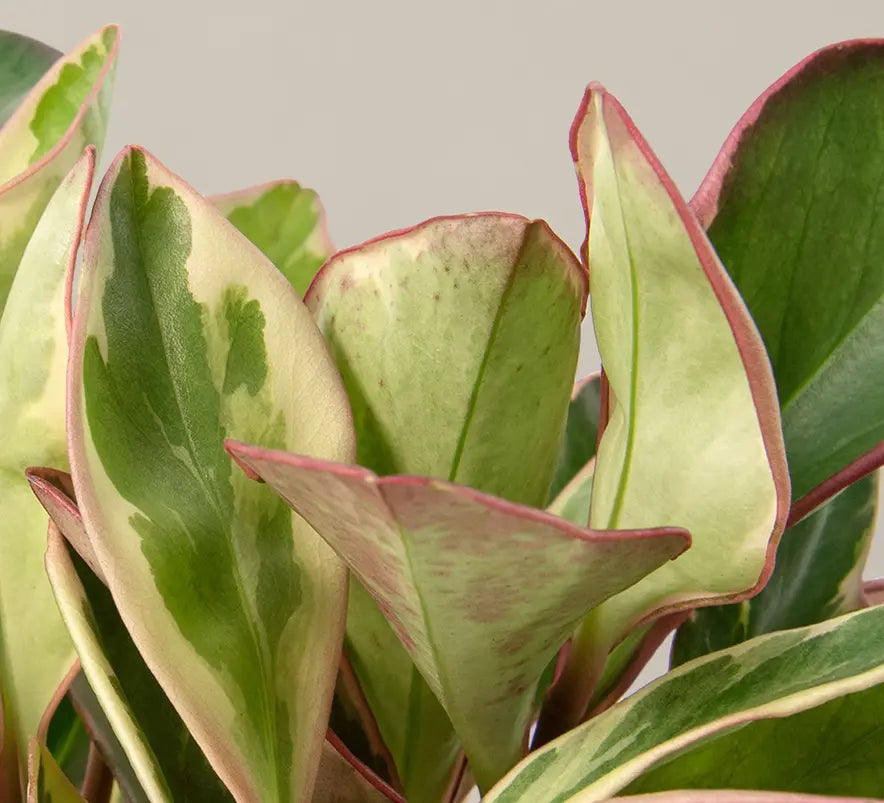
Plants 101
How to Care for a Peperomia Ginny
Learn how to care for the Peperomia Ginny or Tricolor Peperomia—a popular, pet-safe houseplant with colorful, variegated leaves.

Scientifically known as Peperomia clusiifolia, the Peperomia Ginny is a new variation of Peperomia in the Piperaceae family. It is native to South America and is also referred to as the Tricolor Peperomia or the variegated baby rubber tree, thanks to its colorful foliage (fleshy green leaves with yellow and pink edges.) These succulent-like leaves help it retain water, making it a popular low-maintenance houseplant. It can also tolerate lower light conditions, despite its variegation, and with optimal care, can grow up to one foot in height and width.
How much sunlight does a Peperomia Ginny need?
The Peperomia Ginny thrives in medium to bright indirect light. It is not suited for direct afternoon sun. East or West facing windows are ideal, or a diffused South window. The Peperomia Ginny can tolerate low light conditions a North window can provide.
How often should you water a Peperomia Ginny?
Water every 1-2 weeks, allowing the potting mix or soil to dry out between waterings. Expect to water more often in bright light conditions. Leaves that yellow then drop, combined with moist potting mix, can be a sign of overwatering.
Do peperomia plants like high humidity?
Most varieties of peperomia, including the Peperomia Ginny, can tolerate normal/moderate room humidity thanks to their thick, waxy leaves that help them to retain moisture. If the air in your home is usually dry and arid, consider boosting humidity levels for your Peperomia to help it thrive.
When should I pot or repot the Peperomia Ginny?
Allow your Peperomia Ginny to acclimate to its new environment for about two weeks before you consider potting or repotting. Any standard, well-draining potting mix works for potting or repotting the Peperomia Ginny.
What temperature does a Peperomia Ginny prefer?
Like most common houseplants, Peperomia plants prefer an average indoor temperature of 65°F to 75°F. If you’re comfortable in your space, your houseplants probably are, too. Remember to keep plants away from heating and cooling systems, or open doors and windows, that can cause temperature fluctuations and drafts.
Is the Peperomia Ginny safe for cats and dogs?
Peperomia, including the Peperoma Ginny, are non-toxic, pet-friendly plants—making them safe to keep around your furry friends. However, the best practice is always to keep new houseplants out of reach of small children and curious pets.
Can you propagate a Peperomia Ginny?
Peperomia can be easily propagated by taking stem cuttings or dividing the stems via root division at the time of potting.
Is the Peperomia Ginny easy to care for?
Peperomia plants are generally easy houseplants to grow. They are resistant to most plant pests, however, treat houseplant pests as soon as they appear with weekly sprays of neem oil or an insecticide, and regular wipe-downs of the infected plant. Other common plant problems you can look out for are:
- Drooping or wrinkling leaves, dry potting mix: Thirsty plant, underwatered
- Mushy black stems, wet potting mix: Root rot, overwatered
- Leaf drop: Underwatered, or low light

Words By The Sill
Empowering all people to be plant people—a collection of articles from The Sill's team of plant experts across a variety of plant care topics to inspire confidence in the next generation of plant parents. Welcome to Plant Parenthood™.
Do Some Plant Shopping